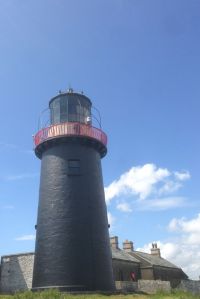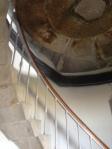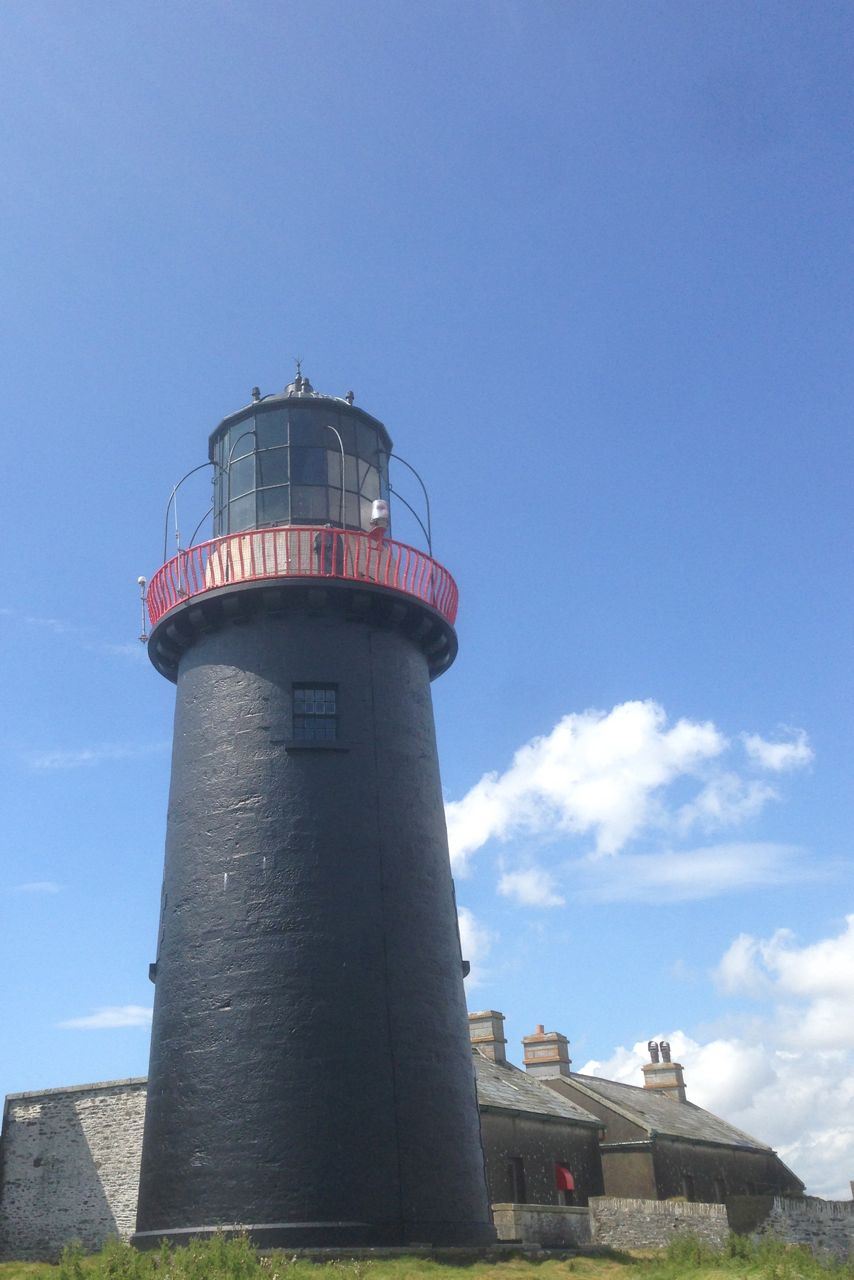 The General Synopsis At Midnight heads for East Cork and Waterford, where sea areas Fastnet, Lundy and Irish Sea all get a look-in.
The General Synopsis At Midnight heads for East Cork and Waterford, where sea areas Fastnet, Lundy and Irish Sea all get a look-in.
‘I’d a hen party out here last Monday,’ the tour guide says. We’re walking up the hill from the small jetty at Ballycotton Island to the lighthouse. Between the matt black – this lighthouse is one of only two in Ireland painted black – and the red glow from the lamps at the top, it looms ahead like an overgrown Tardis. I’m half expecting the Doctor Who of my childhood, all curly hair and long scarf, to appear around the bend, accompanied by a pulsating woo-hoo-woo soundtrack. We pause half way up at what she tells us is called the ‘elbow’. The lighthouse keepers would stop here for a breather while lugging their provisions from the boat to the top. (The keepers had hens, goats and a flourishing kitchen garden, presumably in an attempt to keep the hauling uphill to a minimum.) But there wouldn’t be a lighthouse at Ballycotton – black or otherwise – if it wasn’t for the ill-fated paddle-steamship Sirius. Work on a new lighthouse on nearby Capel Head was already well underway when the Sirius struck Smith’s Rock south west of Ballycotton early one foggy Saturday morning in January 1847. In April 1838 it had found fame as the first vessel to cross the Atlantic Ocean completely under steam, but the treacherous underwater rocks of East Cork and terrible weather conditions meant the end for the Sirius (not to mention 19 of those on board). The London Daily News a few days later reported, ‘…amidst the confusion and alarm that prevailed the life-boat which is usually carried over the paddle-box was attached to the davits and lowered though unfortunately on the wrong side of the ship … melancholy to relate, she was swamped and all in her met a watery grave save Captain Cameron of the Prince river steamer who was a passenger from Dublin in the vessel.’ As a result, it was decided to build the lighthouse on the nine-acre site of Ballycotton Island instead. It commenced operation in 1851 and was permanently staffed by keepers until it was converted to automatic in 1992 and placed in the care of an attendant. Gulls and goats have had their run of the place for years, but thanks to an active local campaign and the support of the Commissioners for Irish Lights, they are once more forced to share it with the newly-launched Ballycotton Island Lighthouse Tours. Two small cottages sit to one side of the lighthouse. One was once used for accommodation until in the 1970s a new building took over this function. An unfortunately ugly lump of a thing, locals call it the Ballycotton Hilton (see image below). ‘It looks like my primary school,’ a man remarks. The closer I get to the lighthouse itself, the more benign the black and red colour palette becomes, and once through the door it is nothing other than beautiful. From the 1.5m thick sandstone walls to the stairs made from granite slabs, our little tour group clusters inside the door to marvel at the labour that created this example of Victorian precision and dedication. Above us, an oak handrail curls upwards and the dark twists of the ceiling are that of a fossilized shell (see image to the right, below). It’s a hot day and outside at the foot of the lighthouse the air was still and unmoving. It hung heavy, smelling of calm seas and dry grass. Yet several floors up on the observation deck a breeze whips crossly around us. 
 On this brightly blue afternoon it’s hard to believe any other weather can exist, yet there must have been many, many days and nights when the hearths and homes of the mainland seemed impossibly far away to the keepers. Today even the clouds are the sort painted by a 17th century Dutch Master with a spare bottle of titanium white and time on his hands. The head of an occasional seal breaks the waves and bobs around before dropping under the water once more. The wildlife regard us human visitors with disinterest. (‘That rock is moving!’ a woman exclaims. ‘It’s a goat!’ a little girl tells her.) When our time is up, we stroll back down the hill to the jetty so that our tour can swap over with the next one. The incoming guide recognises a woman in my group. ‘What are you doing on my island?’ she asks as they hug. The boat leaves the island and chugs back to the harbour. The skipper is a man whose father’s boat brought the provisions out to the keepers. His father before him was on the RNLB Mary Standford, famous for the Daunt Lightship Rescue in 1936. Its crew won well-deserved medals for gallantry, as did the boat itself (a gold one, no less). We are still talking about the hen party. There were nine of them took the tour, the guide tells us. Every one of them local, they’d all been looking at the lighthouse their whole lives. ‘Still though, a hen party?’ a woman repeats, incredulous, before deciding,‘it must have been a very sophisticated hen party, so.’
On this brightly blue afternoon it’s hard to believe any other weather can exist, yet there must have been many, many days and nights when the hearths and homes of the mainland seemed impossibly far away to the keepers. Today even the clouds are the sort painted by a 17th century Dutch Master with a spare bottle of titanium white and time on his hands. The head of an occasional seal breaks the waves and bobs around before dropping under the water once more. The wildlife regard us human visitors with disinterest. (‘That rock is moving!’ a woman exclaims. ‘It’s a goat!’ a little girl tells her.) When our time is up, we stroll back down the hill to the jetty so that our tour can swap over with the next one. The incoming guide recognises a woman in my group. ‘What are you doing on my island?’ she asks as they hug. The boat leaves the island and chugs back to the harbour. The skipper is a man whose father’s boat brought the provisions out to the keepers. His father before him was on the RNLB Mary Standford, famous for the Daunt Lightship Rescue in 1936. Its crew won well-deserved medals for gallantry, as did the boat itself (a gold one, no less). We are still talking about the hen party. There were nine of them took the tour, the guide tells us. Every one of them local, they’d all been looking at the lighthouse their whole lives. ‘Still though, a hen party?’ a woman repeats, incredulous, before deciding,‘it must have been a very sophisticated hen party, so.’ 
Want to sea more? The Commissioners for Irish Lights: cil.ie The Ballycotton Lighthouse: http://www.ballycottonislandlighthousetours.com/ A great read is the memoir ‘The Lightkeeper’ by Gerald Butler, published by Liffey Press. And a footnote involving sea areas Irish Sea and Fastnet: This wreck is to be found 40k from the Ballycotton Lighthouse, in Co. Waterford. It’s the wreck of the crane barge Samson, which came a cropper on a journey from Liverpool to Malta in December 1987 in a fierce south-easterly gale. Its tow-line broke off the Welsh coast and it ran aground at Rams Head, Ardmore. Apparently a man called Jim Rooney managed to climb onto the crane and lived there for 40 days in order to claim salvage. Samson reminds me of the skeleton of an extinct bird. A doomed, flightless creature: something I’d stare at in a museum and wonder how it ever flew at all.
 Thanks to Ivan Fitzpatrick for the Samson image.
Thanks to Ivan Fitzpatrick for the Samson image.
The General Synopsis At Midnight is my exploration of the sea areas of the BBC R4 Shipping Forecast, thanks to the Maeve Binchy Travel Award. The earlier post ‘Counting Down To Midnight’ explains what I’m up to and where I’m going.
